Post by Aaron Eisen, PSU graduate in Psychology and Social Science, OHSU research/teaching assistant, graduate student at the National University of Natural Medicine, and NW Noggin Resource Council member for Communications
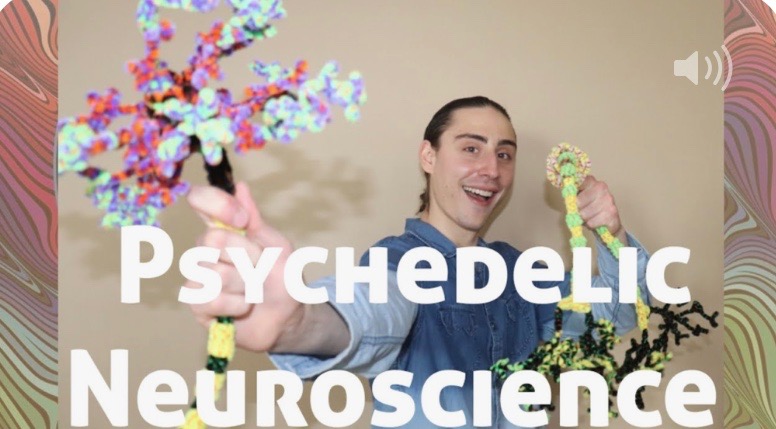
There is a renaissance of psychedelic therapy underway, and growing interest in the underlying mechanism of these medicines as well as their clinical relevance. The Portland Psychedelic Society is the second largest psychedelic society in the world (after London) and regularly hosts events which provide a framework for “psychonauts,” researchers, students, and clinicians to come together to bolster the growing momentum.
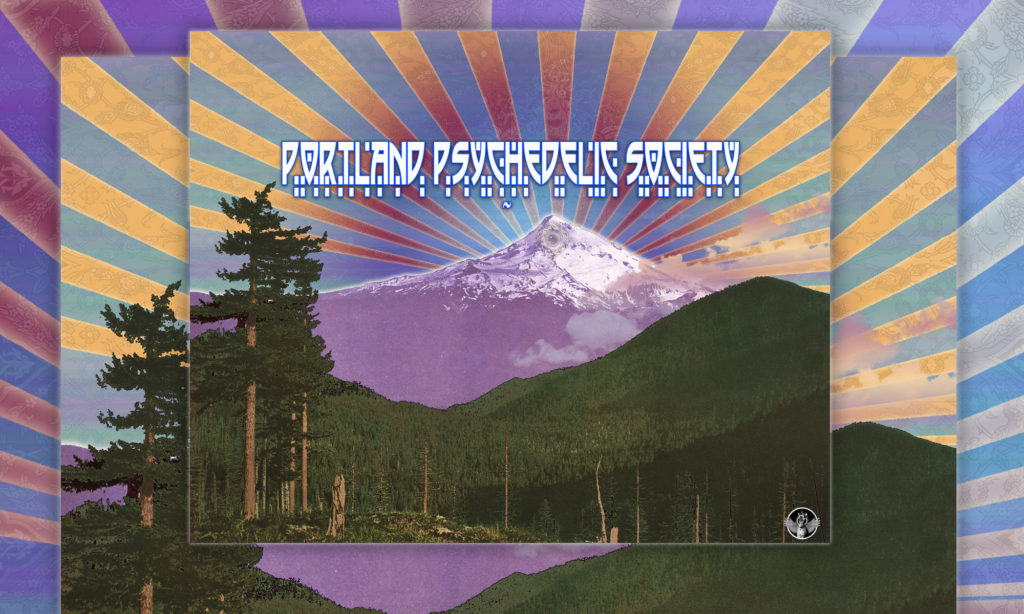
LEARN MORE: The Psychedelic Renaissance
LEARN MORE: Psychedelic-Assisted Psychotherapy: A Paradigm Shift in Psychiatric Research and Development
LEARN MORE: A less self-centered and more creative life
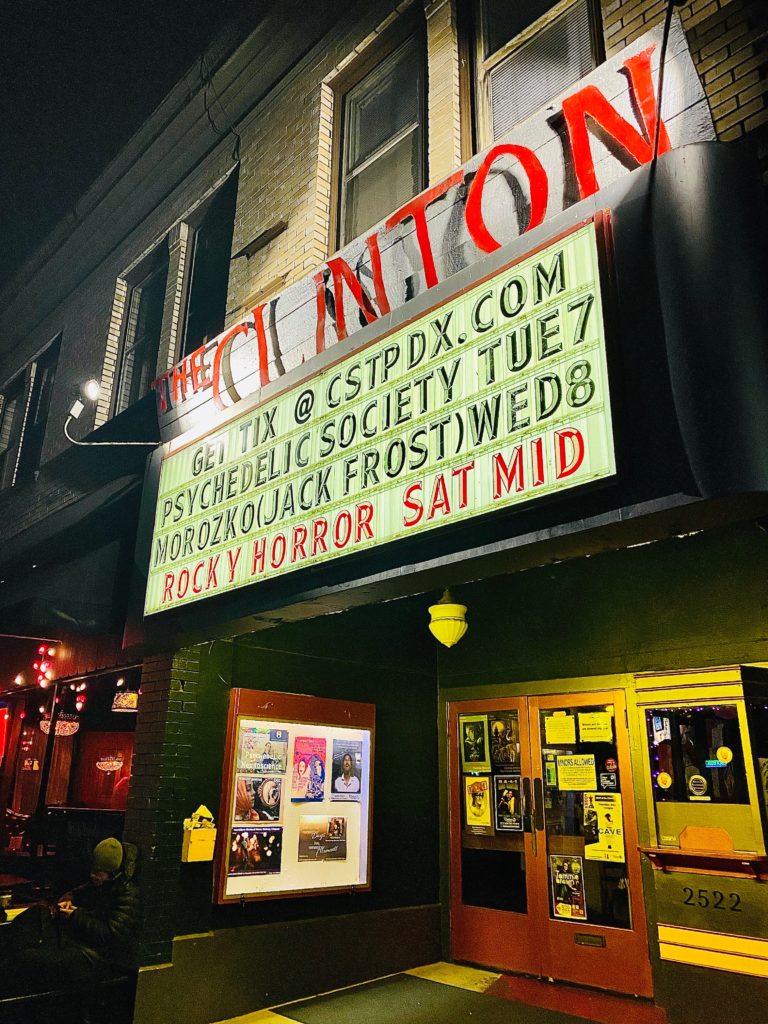
In a recent lecture at the Clinton Street Theater we discussed the neuroscience behind psychedelics, how “microdosing” might alter our creative and cognitive experiences, how psilocybin can help patients with treatment resistant depression, how MDMA could help patients with PTSD, the dangers and challenges associated with psychedelics, and how someone could become a legitimate (legal) psychedelic researcher or clinician.
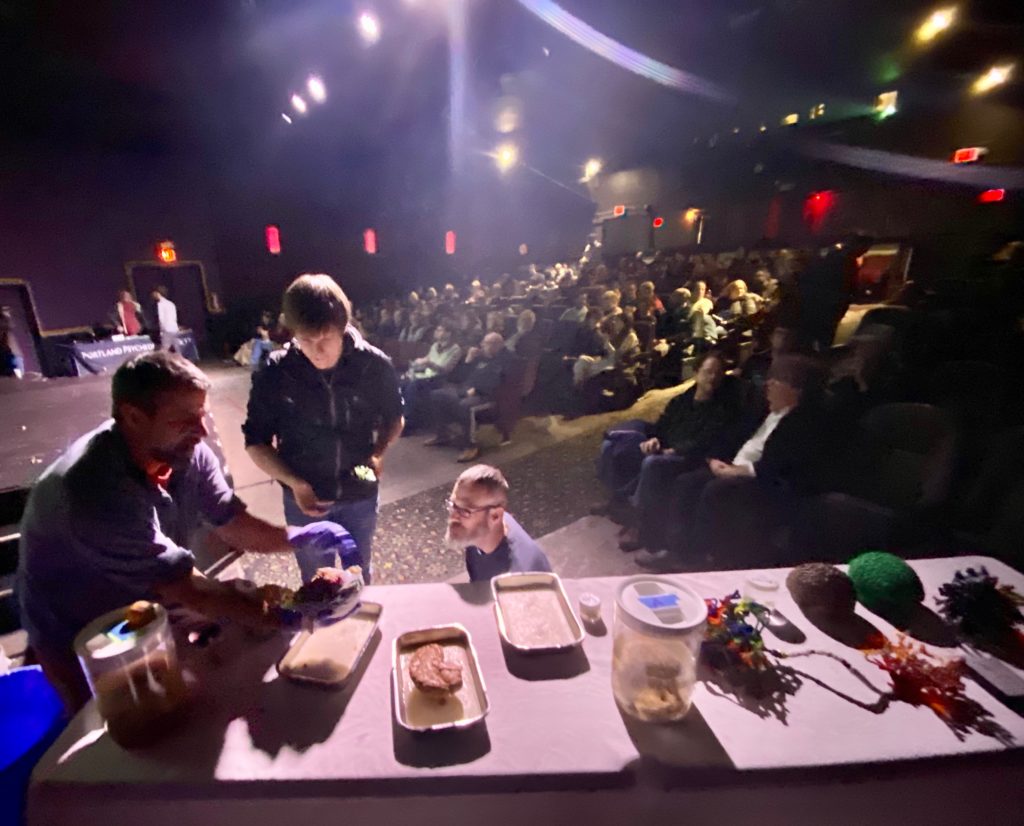
LEARN MORE: Psychedelic Neuroscience!
A defining quality of any psychedelic is its ability to bind to and “activate” (i.e., act as an “agonist” at) the 5HT-2A receptor (one of fifteen different receptors for the neurotransmitter serotonin).
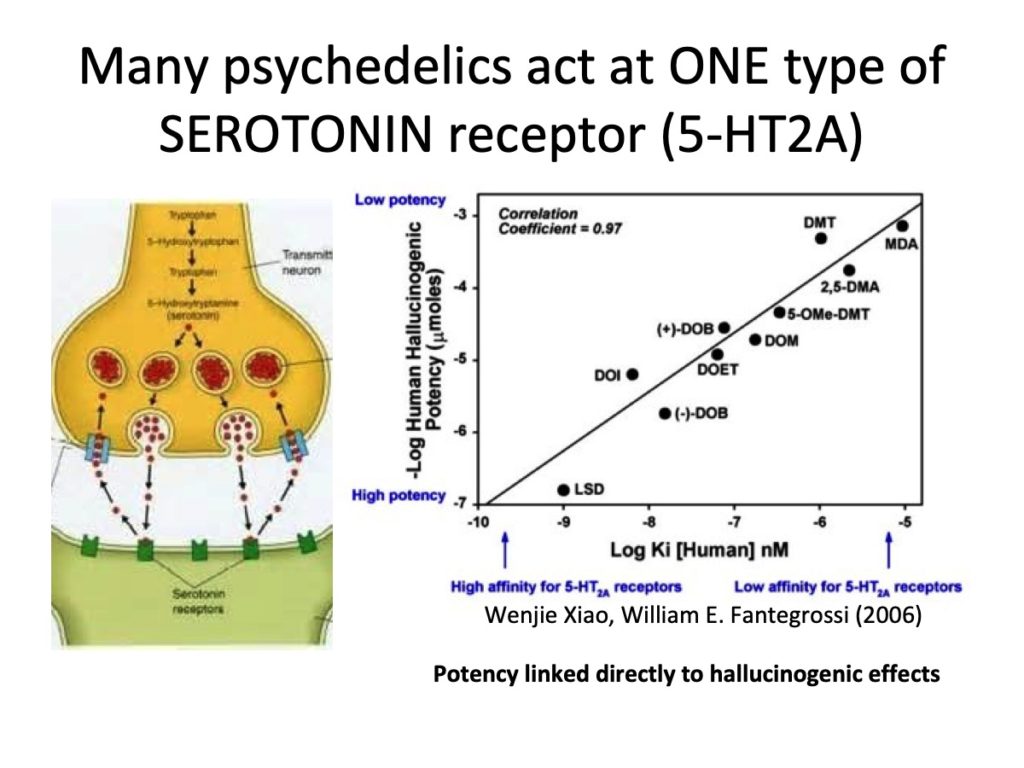
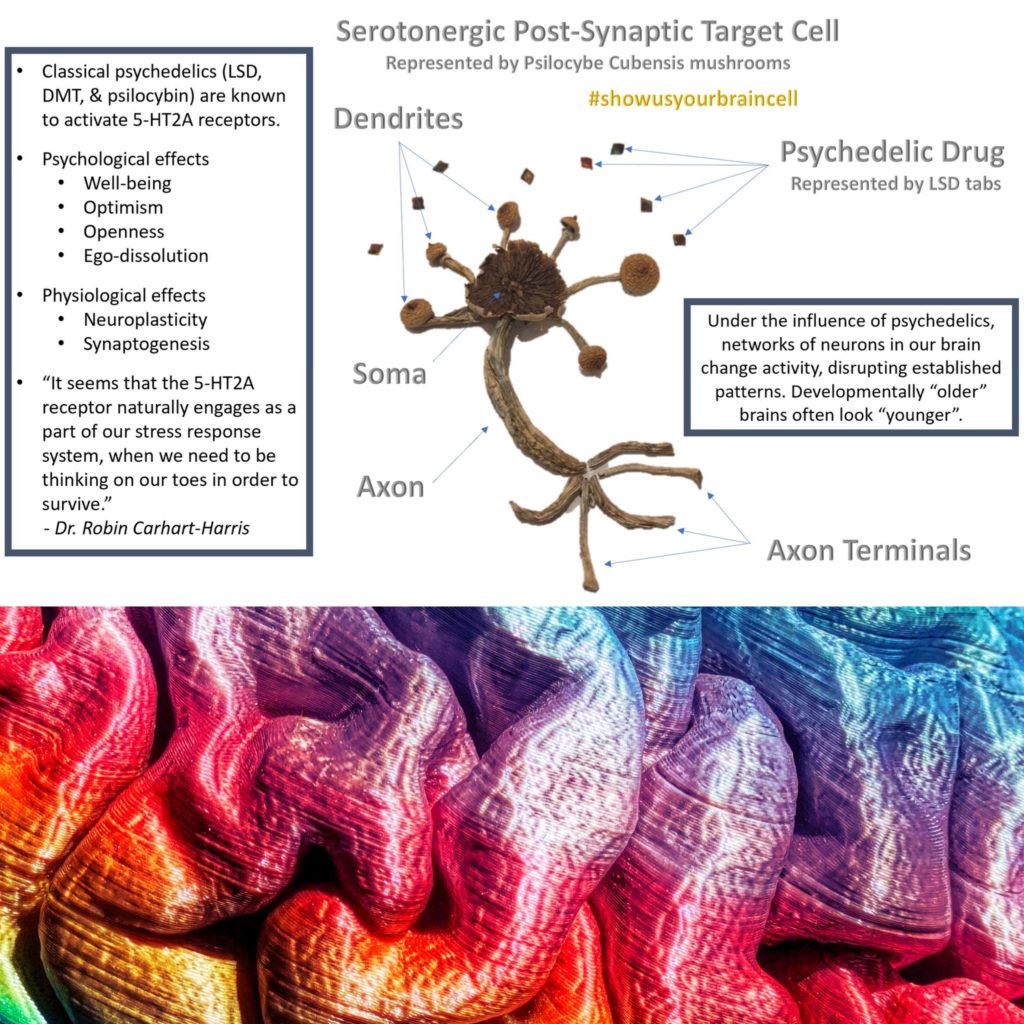
The affinity for a psychedelic to bind to the 5HT-2A receptor is strongly correlated with its potency. For example, LSD (which is one of the most potent psychedelics) has one of the highest affinities for the 5HT-2A receptor. The 5HT-2A receptor is found to be expressed more during key developmental periods when an individual is learning so much and soaking up new information like a sponge. Higher levels of neuronal plasticity and thus adaptability seems to correlate with a greater expression of the 5HT-2A receptor which suggests that the 5HT-2A receptor may actually play a role in neuronal plasticity and adaptation. Research has shown that the most reliable way to upregulate 5HT-2A expression naturally (not under the influence of psychedelics) is through stress. Perhaps this is why this receptor is there, when we need to be thinking on our toes or especially adaptable, this system engages to improve our chances of survival.
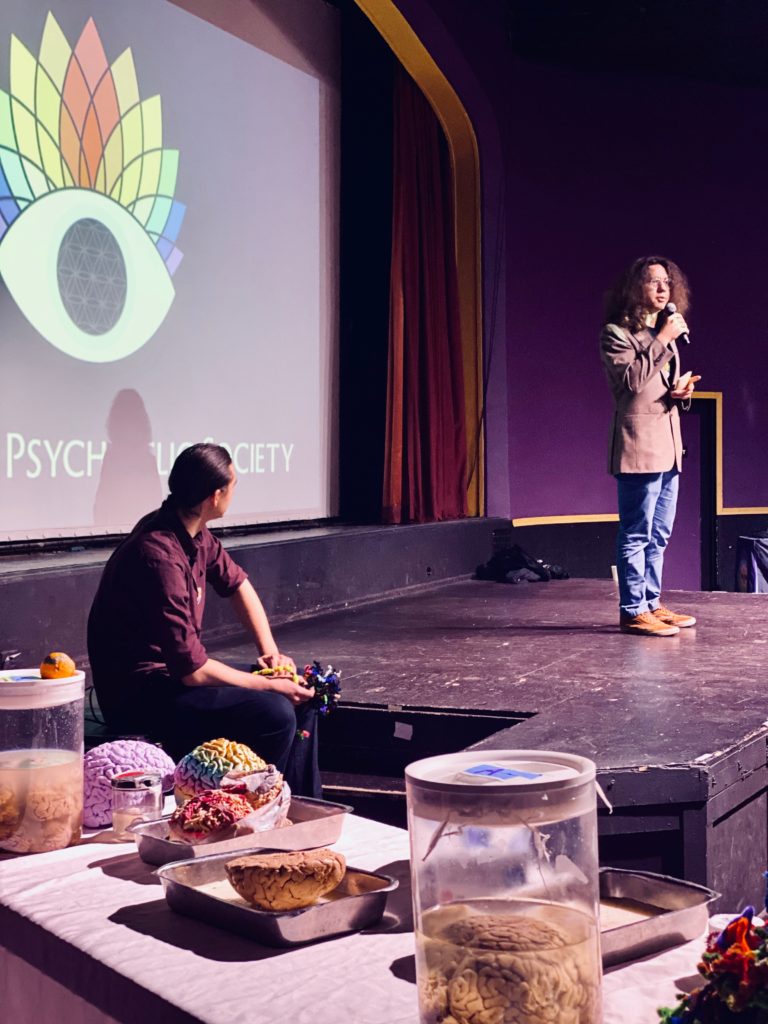
LEARN MORE: Serotonin and brain function: a tale of two receptors
LEARN MORE: The role of serotonin 5-HT2A receptors in memory and cognition
LEARN MORE: Greater loss of 5-HT(2A) receptors in midlife than in late life
LEARN MORE: Serotonin 2A receptors are a stress response system: implications for post-traumatic stress disorder
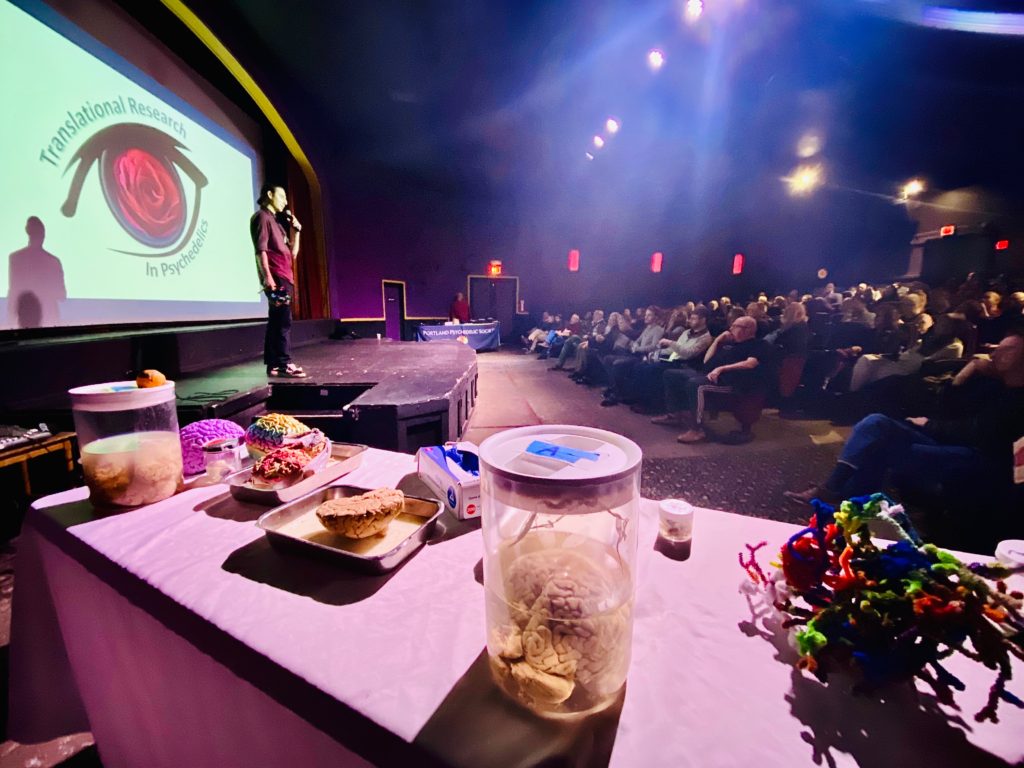
Agonism of the 5HT-2A receptor is also associated with the growth of new neurons in the cortex (“neurogenesis“) as well as the growth of the structural components of neurons (dendrites and axon terminals) which suggests that psychedelics might increase neuronal plasticity and promote synaptogenesis.
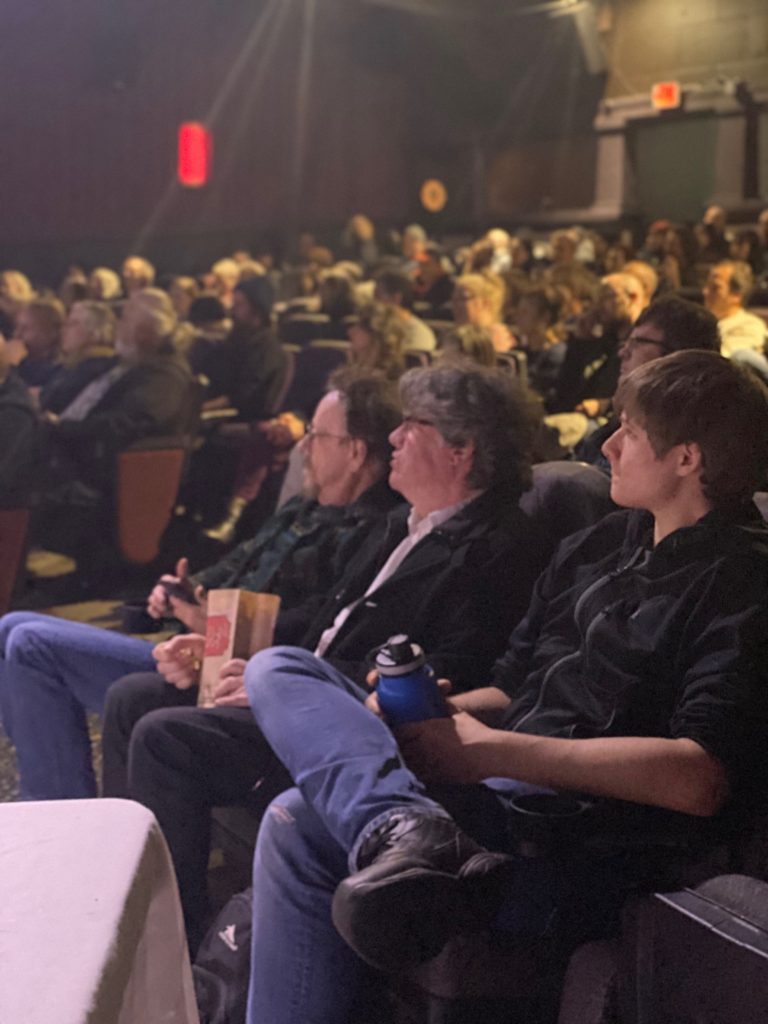
Furthermore, the subjective effects of 5HT-2A agonism includes well-being, optimism, openness, and ego-dissolution. This is helpful when there is a need for flexibility to break rigid thought patterns or strongly held beliefs.
“Psychedelics are illegal because they dissolve opinion structures and culturally laid down models of behaviour and information processing. They open you up to the possibility that everything you know is wrong.”
― Terence McKenna

LEARN MORE: Psychedelics Promote Structural and Functional Neural Plasticity
LEARN MORE: Ego-Dissolution and Psychedelics: Validation of the Ego-Dissolution Inventory (EDI)
LEARN MORE: Finding the self by losing the self: Neural correlates of ego-dissolution under psilocybin
LEARN MORE: The default-mode, ego-functions and free-energy: a neurobiological account of Freudian ideas
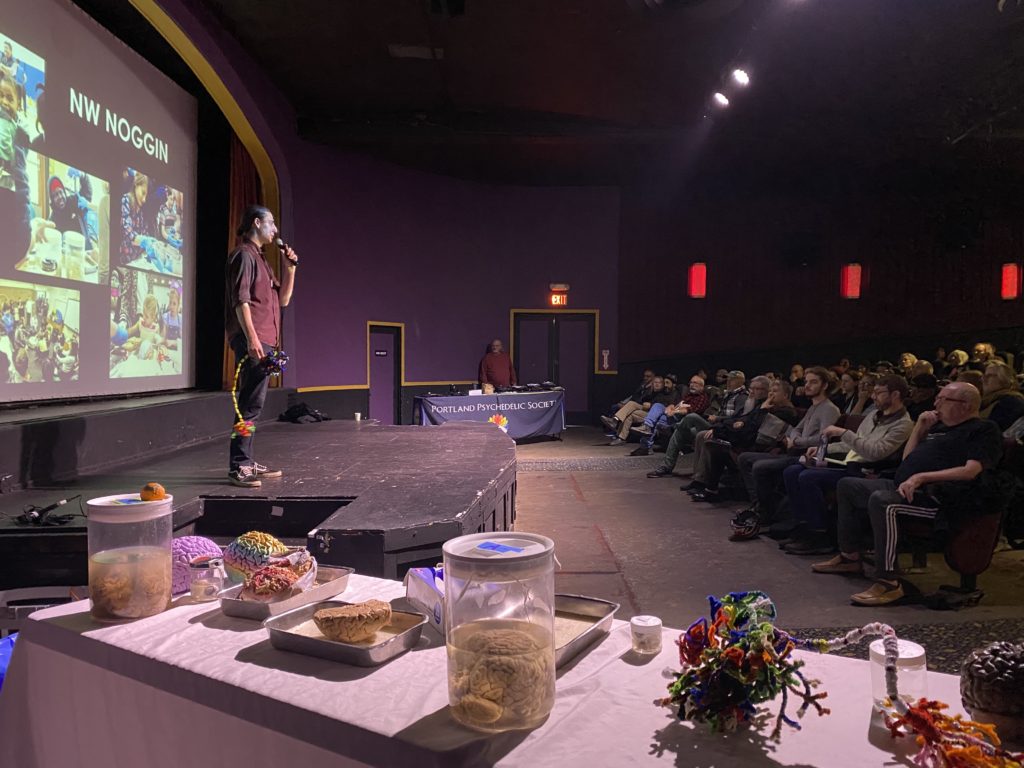
The 5HT-2A receptor is found throughout many different brain regions including the neocortex, olfactory cortex, hippocampus, basal ganglia, thalamus, cerebellum, brainstem, and spinal cord.
However, they are rather scarce in primary motor cortex, which may explain why psychedelics have such profound cognitive effects but rather insignificant effects on movement. The 5HT-2A receptor is one of the main excitatory receptor subtypes for serotonin. However, the 5HT-2A receptor seems to have an inhibitory effect on areas of visual cortex. Perhaps this inhibition creates gaps in our brains’ ability to piece together visual information. To adjust, networks in visual cortex reach out to adjacent regions to fill in the gaps, contributing to visual hallucinations.
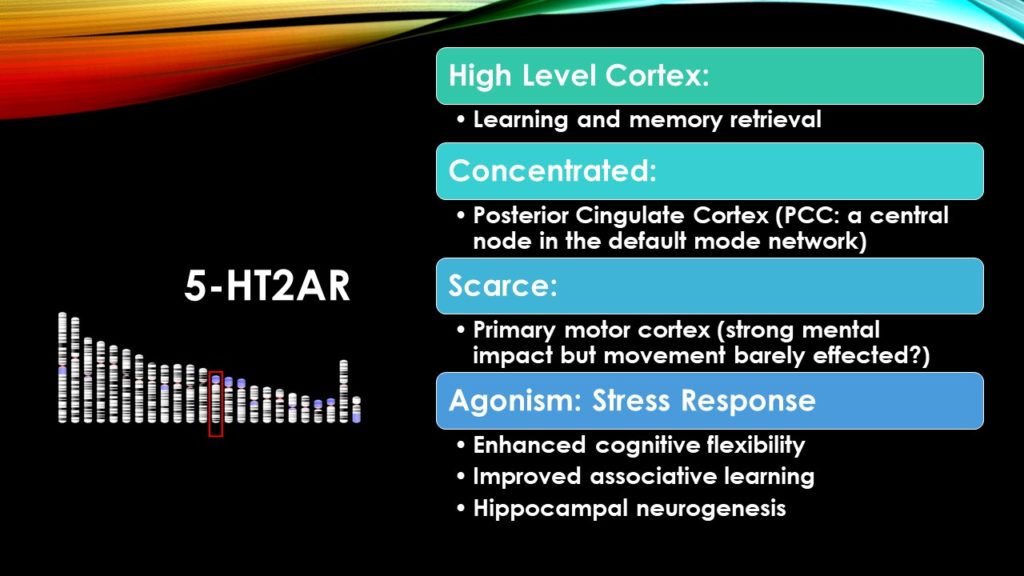
LEARN MORE: Hallucinogens and Serotonin 5-HT2A Receptor-Mediated Signaling Pathways
LEARN MORE: The Mechanisms of Psychedelic Visionary Experiences: Hypotheses from Evolutionary Psychology
LEARN MORE: Are Hallucinations Due to an Imbalance Between Excitatory and Inhibitory Influences on the Brain?
LEARN MORE: LSD alters eyes-closed functional connectivity within the early visual cortex in a retinotopic fashion
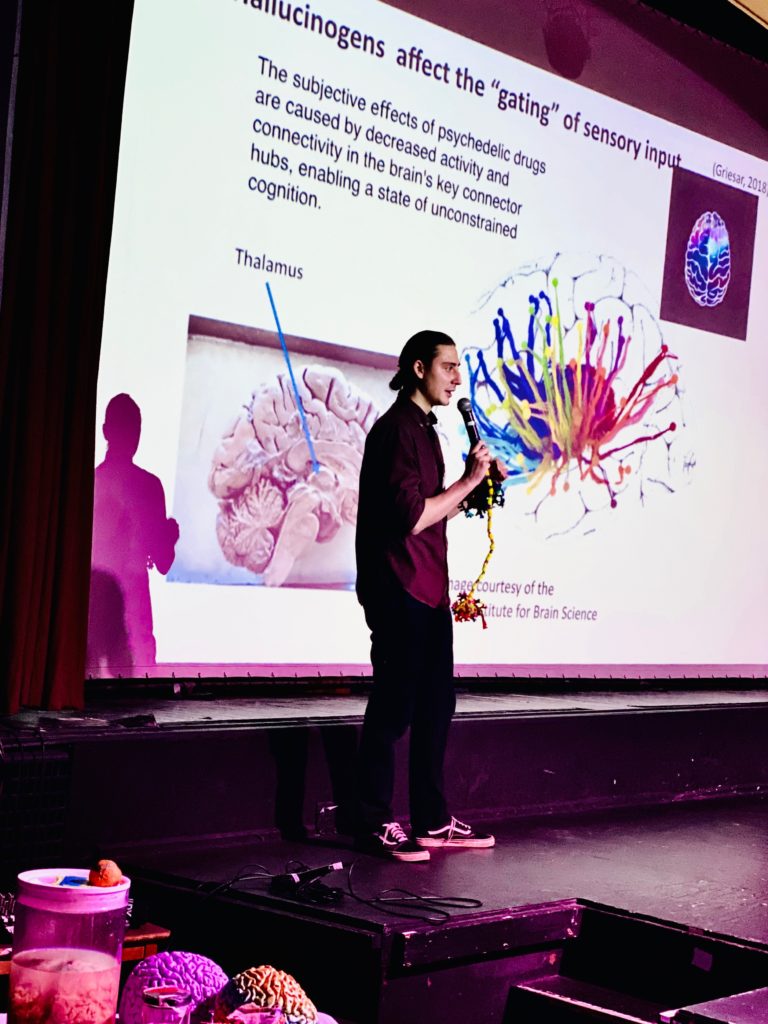
Studies report that during the acute state, psychedelics decrease cerebral blood flow in network “hub” regions of the brain, including the thalamus and the anterior and posterior cingulate cortex.
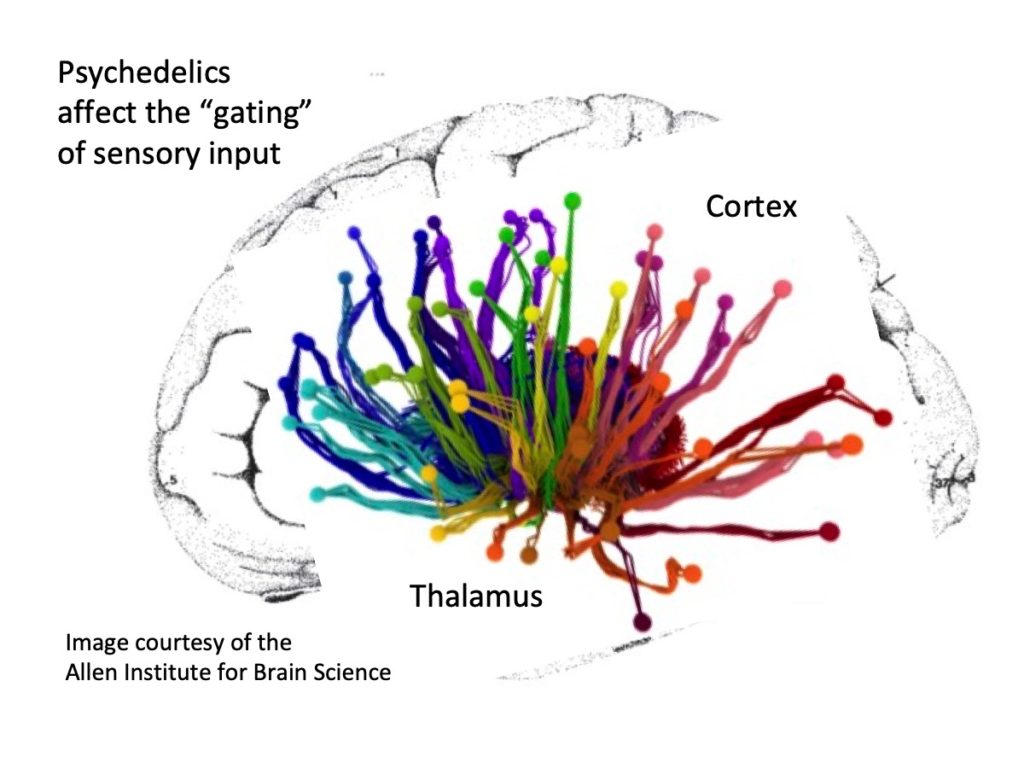
This means that psychedelics seem to disrupt the functions of both the thalamus and what’s termed the “default mode network.” The thalamus is an important structure that sits on top of the brain stem and seems to play a critical role in the gating of sensory input. I like to think of the thalamus as the old school telephone operators who would connect phone calls and send messages to their intended destination.
LEARN MORE: Brain mechanisms of hallucinogens and entactogens
LEARN MORE: Neural correlates of the psychedelic state as determined by fMRI studies with psilocybin
Interruptions in the gating of sensory input may lead to connections occurring between different regions that do not normally occur.
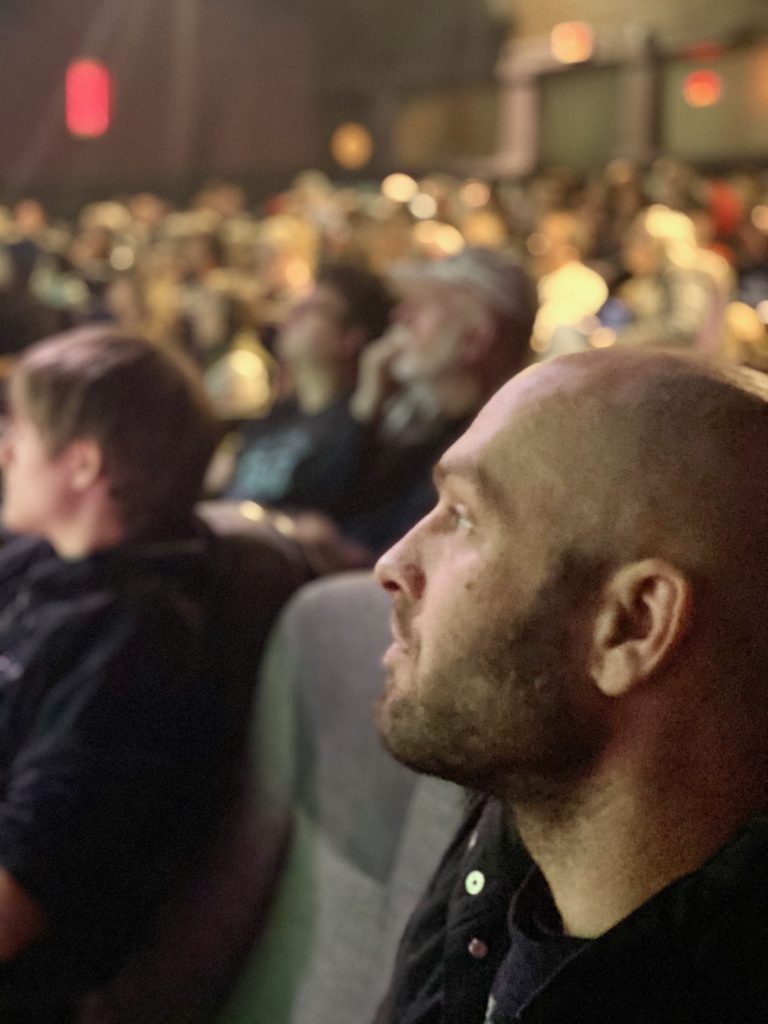
This is why we may experience synesthesia (the mixing of perceptions) when, as an example, auditory sensory input generates activity in our visual system. Also, this may play a major role in why a person may have very different experiences on different occasions and why the psychedelic experience is so dependent on environmental factors. Different sensory inputs from different environments tied with new connections occurring in the brain can lead to the same psychedelic producing very different cognitive effects (“good trips” or “bad trips”) each time it is used.
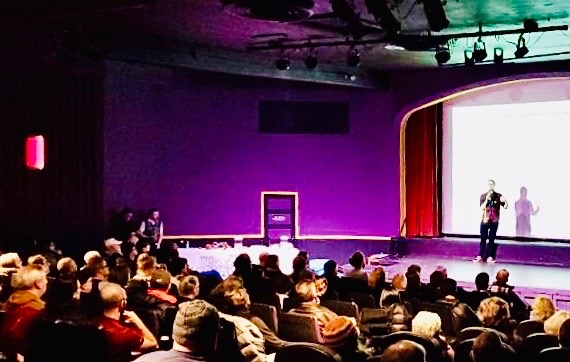
LEARN MORE: The induction of synaesthesia with chemical agents: a systematic review
LEARN MORE: Does LSD induce genuine synesthesia — or something different?
LEARN MORE: A placebo-controlled investigation of synaesthesia-like experiences under LSD
The effect of psychedelics on the thalamus also have been found to cause system “regression.” As a typical brain develops, systems that serve specific functions tend to increase in their integrity, so the different regions that make up that system talk to each other more coherently. Furthermore, different systems that perform different functions become more separate from one another and become functionally segregated. This allows these systems to function with a greater degree of specialization. This specialization helps to increase the processing speed of information and allows adults to make quick decisions but also to jump to conclusions. However, under the influence of psychedelics there is a breakdown of this specialization, a local disintegration, and a global integration promoting low level associative learning, extinction learning (unlearning), and the flexibility of behavior and thought patterns. Developmentally older brains start to look like developmentally younger brains and the ability of the brain to jump to conclusions is hindered. This allows people under the influence of psychedelics to slow down their processing speed and thus (perhaps) take in a “bigger” picture of experience.

LEARN MORE: Unifying Theories of Psychedelic Drug Effects
LEARN MORE: Altered Insula Connectivity under MDMA
LEARN MORE: Increased Global Functional Connectivity Correlates with LSD-Induced Ego Dissolution
LEARN MORE: Effects of psilocybin on hippocampal neurogenesis and extinction of trace fear conditioning
Psychedelics also disrupt the previously mentioned default mode network, which is critical for self-reflection, self-awareness, and rumination.
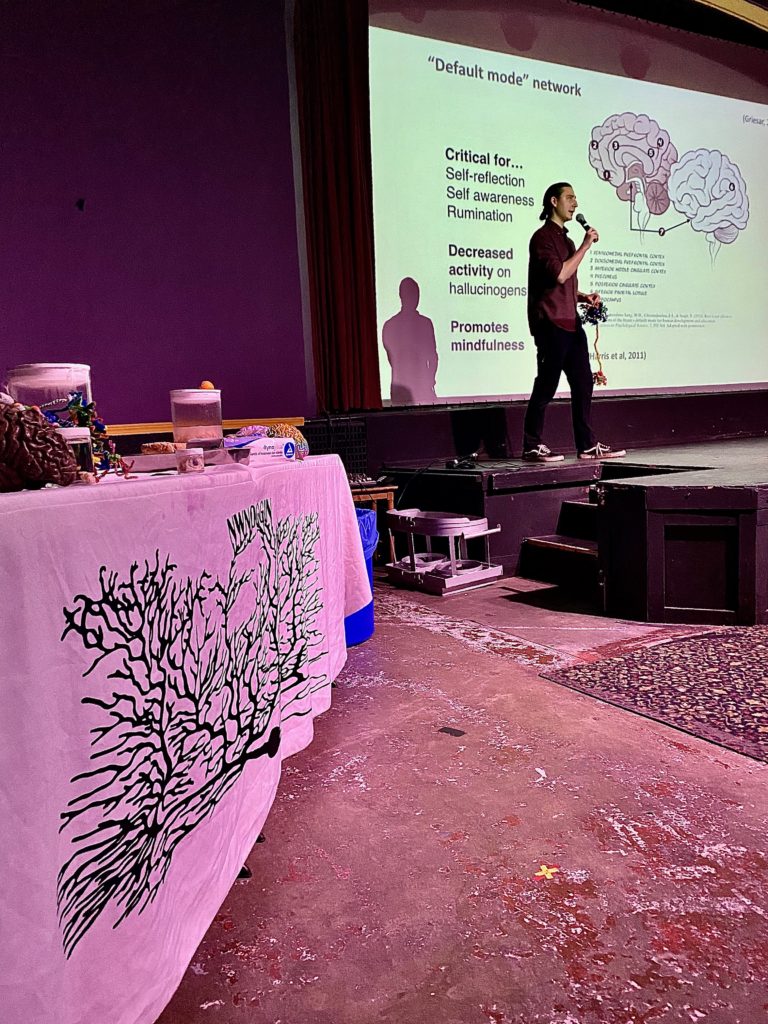
When you are daydreaming, thinking about what you want to eat for dinner, or considering what you want to do on you day off next Tuesday, this is facilitated by your default mode network. The disruption of the default mode network likely impairs self-reflection. It also may be why it is so difficult to plan out future activities while being in the middle of an LSD trip. Interestingly, the default mode network is also interrupted during other activities such as meditation, which is associated with enhanced awareness of the immediate moment – a form of mindfulness.
LEARN MORE: Mindfulness Matters (NIH)
LEARN MORE: Psychedelics, Meditation, and Self-Consciousness
LEARN MORE: The entropic brain: a theory of conscious states informed by neuroimaging research with psychedelic drugs
LEARN MORE: Psilocybin-Assisted Therapy: A Review of a Novel Treatment for Psychiatric Disorders
Psychedelics have also been found to enhance the sensory response of a structure in your brainstem called the locus coeruleus (the “blue spot”).
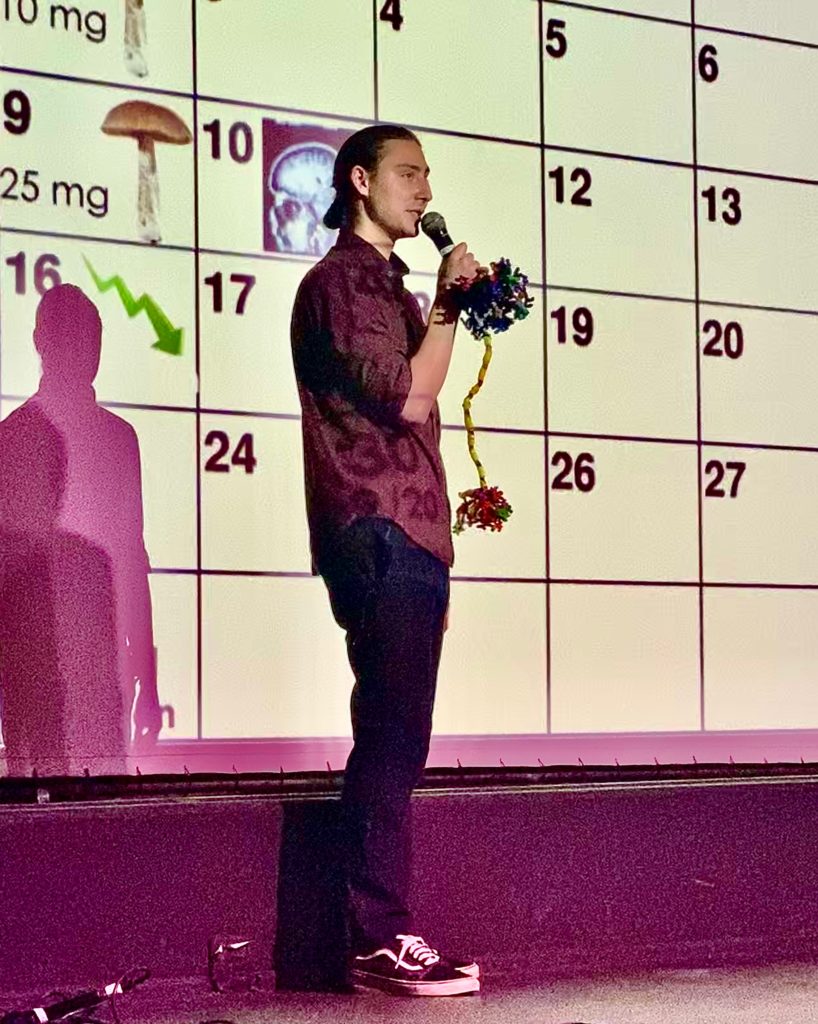
The locus coeruleus is part of your brain’s “orientation” network. Novel or unexpected stimuli set it off. If you were to step out into a road and a car came speeding towards you, this network would orient you to look towards the car to get out of the way as fast as possible to avoid injury. Psychedelics seem to hijack this network and orient a person to things they may not be normally oriented to, such as their hand…or the patterns on a rug…or a beautiful chair…
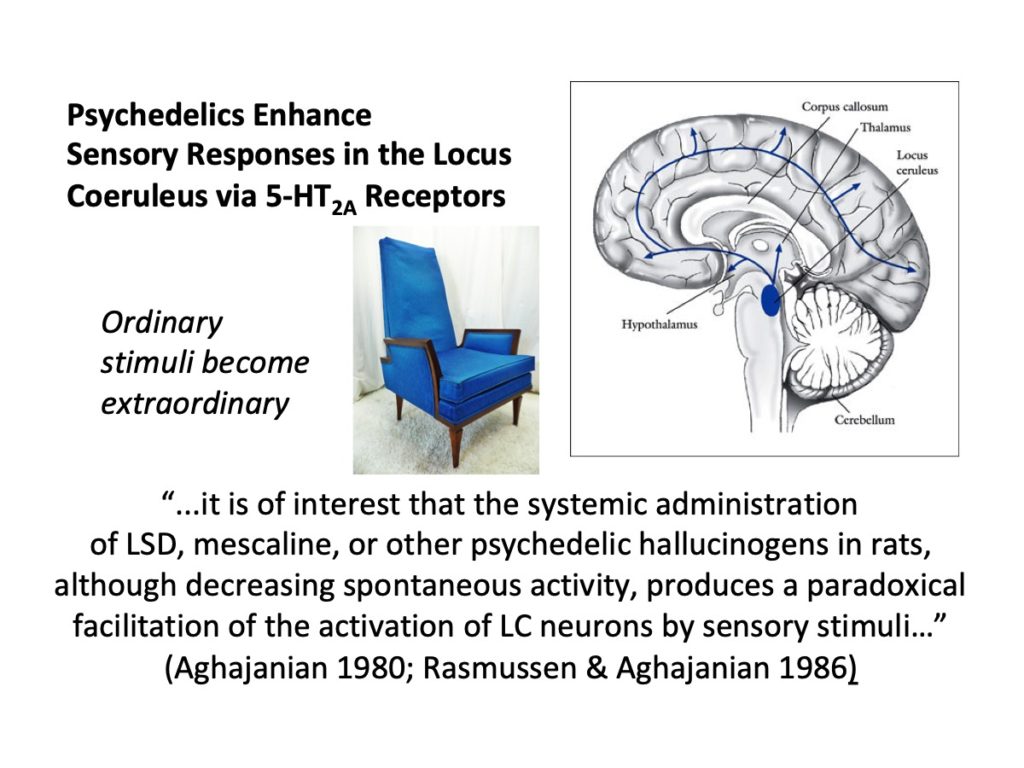
In other words, ordinary stimuli become extraordinary!
LEARN MORE: Mescaline and LSD facilitate the activation of locus coeruleus neurons by peripheral stimuli
Recent research has shown that psychedelics are associated with openness, liberalism, and nature relatedness (defined as “I always think about how my actions affect the environment”). This was not found with cocaine or alcohol.
LEARN MORE: Psychedelics, Personality and Political Perspectives
LEARN MORE: If Everyone Tripped on Psychedelics, We’d Do More About Climate Change

Hendricks et al. found that psychedelic use was a greater protector against recidivism (the tendency of a convicted criminal to reoffend) than a stable family, housing, and employment. Additional studies have found that psychedelic use is associated with a reduction in criminal behavior as well as intimate partner violence.
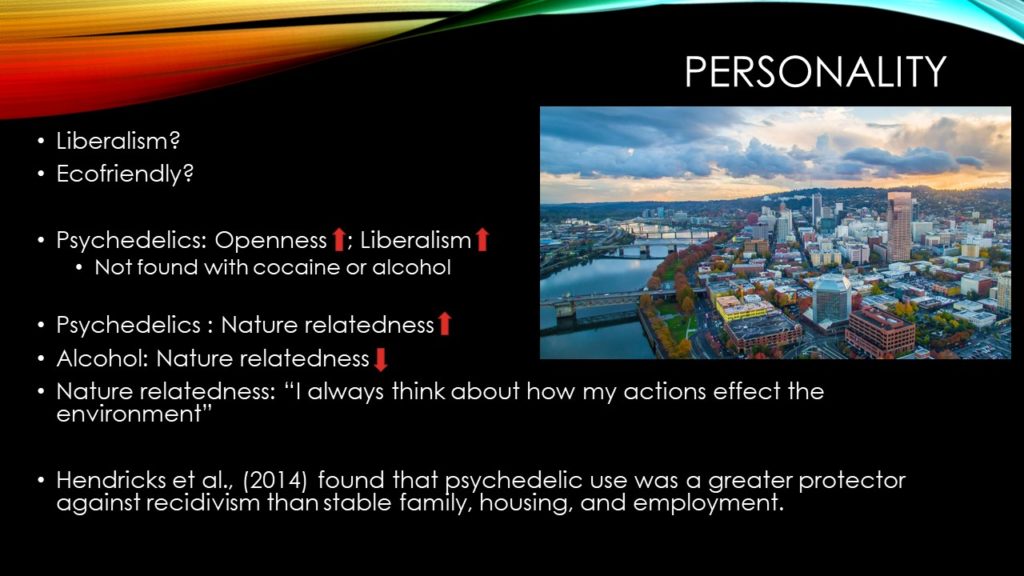
LEARN MORE: The relationships of classic psychedelic use with criminal behavior in the United States adult population
Microdosing (taking a very small dose) seems to be a new trend among psychedelic users.
LEARN MORE: Are Psychedelics the Breakthrough Therapy Drug?
LEARN MORE: I Tried Microdosing With Four Different Psychedelic Drugs. Here’s What Happened
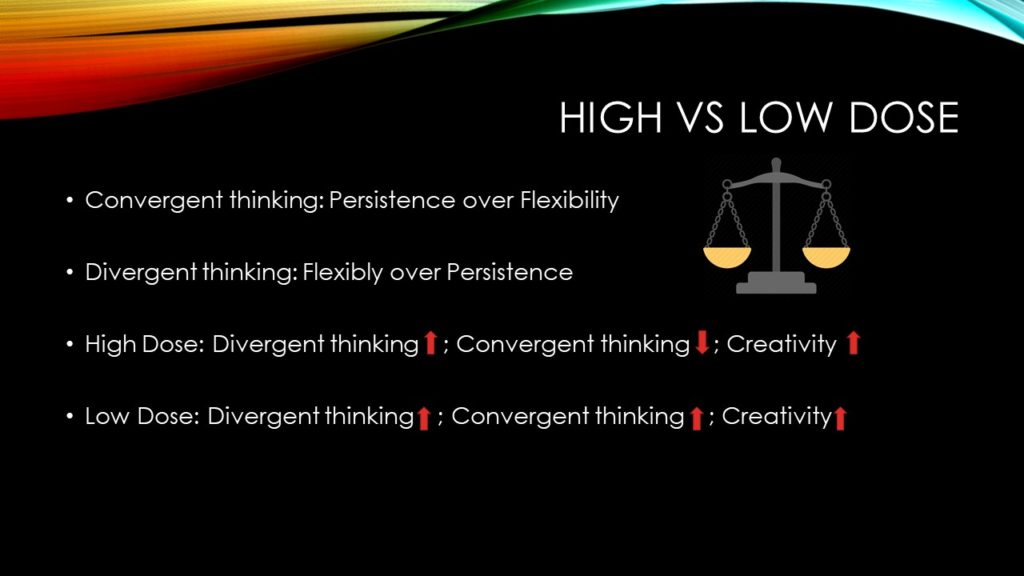
One recent study reported that microdosing increases measures of divergent thinking (flexibility over persistence), convergent thinking (persistence over flexibility), and creativity, while a “macro-dose” (taking a very large dose) increases divergent thinking and creativity but decreases convergent thinking (Prochazkova et al., 2018).
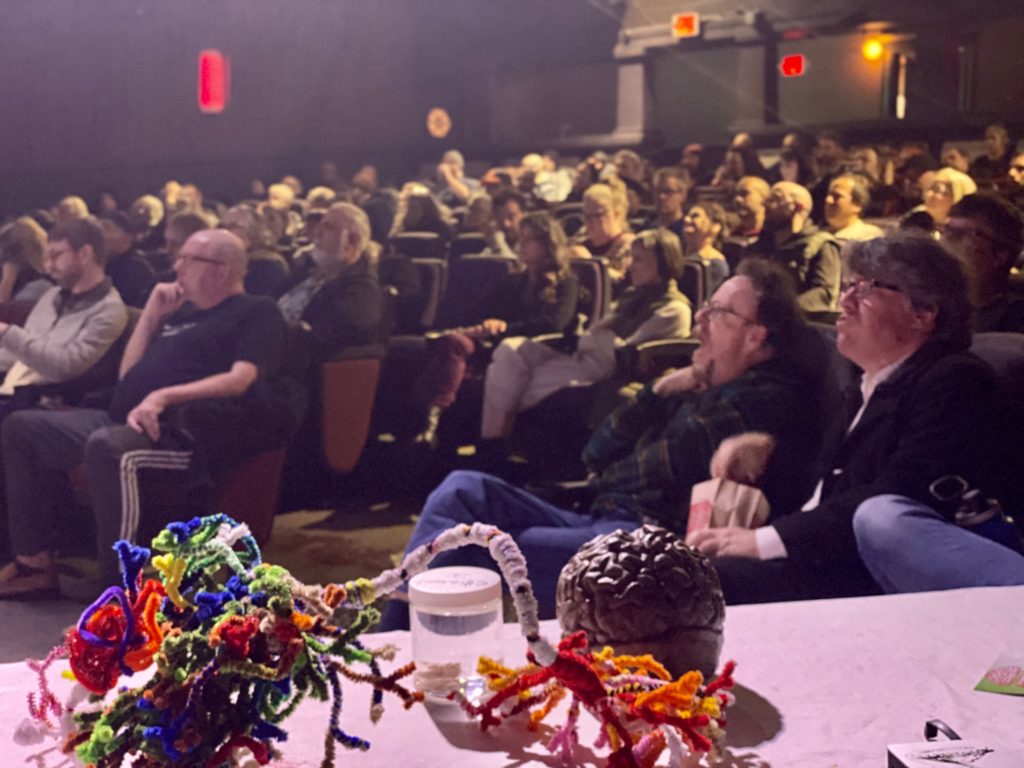
LEARN MORE: Exploring the effect of microdosing psychedelics on creativity in an open-label natural setting
LEARN MORE: Microdosing psychedelics: personality, mental health, and creativity differences in microdosers
It seems that the 5HT-2A receptor also has an indirect modulatory effect over dopamine regulation. Microdosing is thought by some researchers to promote the most effective “mind zone,” enhancing motivation and focus while reducing distractibility and procrastination. This may be why some entrepreneurs in Silicon Valley (such as the late Steve Jobs) have also claimed that microdosing helps them overcoming mental blocks.
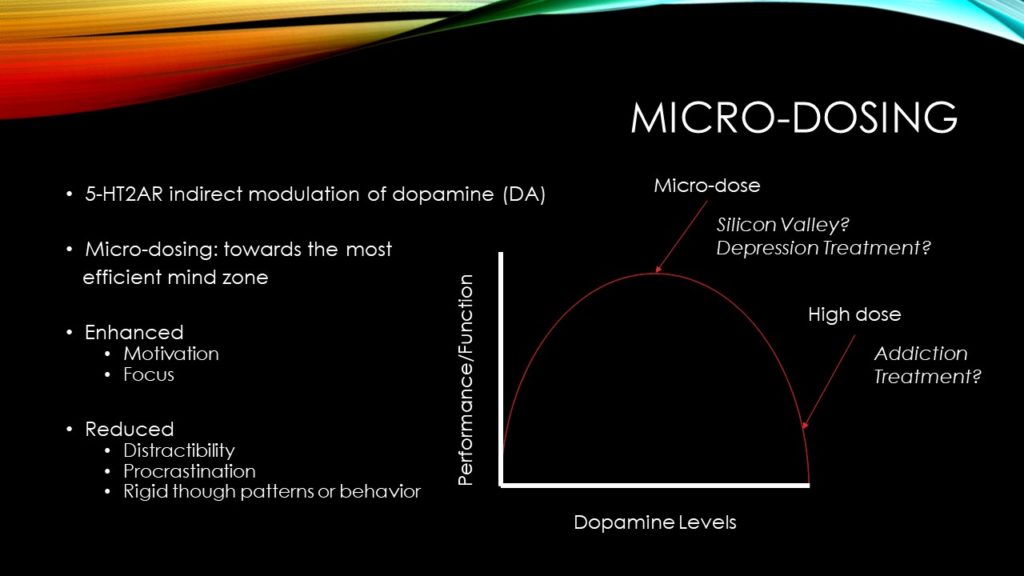
“Taking LSD was a profound experience, one of the most important things in my life. LSD shows you that there’s another side to the coin…”
― Steve Jobs
LEARN MORE: Might Microdosing Psychedelics Be Safe and Beneficial? An Initial Exploration
LEARN MORE: A systematic study of microdosing psychedelics
LEARN MORE: LSD ‘microdosing’ is trending in Silicon Valley – but can it actually make you more creative?
Serotonin itself seems to play an important role in an organism’s sensitivity to context (environmental factors). Research in humans and animals has shown manipulating serotonin modulates an organism’s sensitivity to the environment. However, this is a complex relationship that depends on the context of an environment.
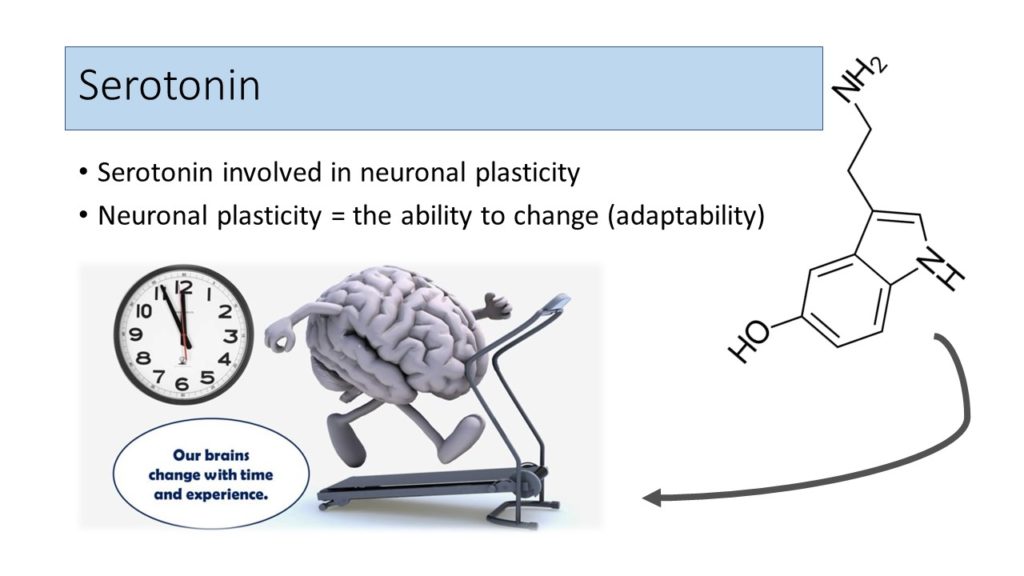
Increasing serotonin does not necessarily increase “positive mood.” In fact, research has revealed that increasing serotonin in enriched environments increases the positive effects of the environment, but increasing serotonin in adverse environments has been found to increase the negative response to an environment.
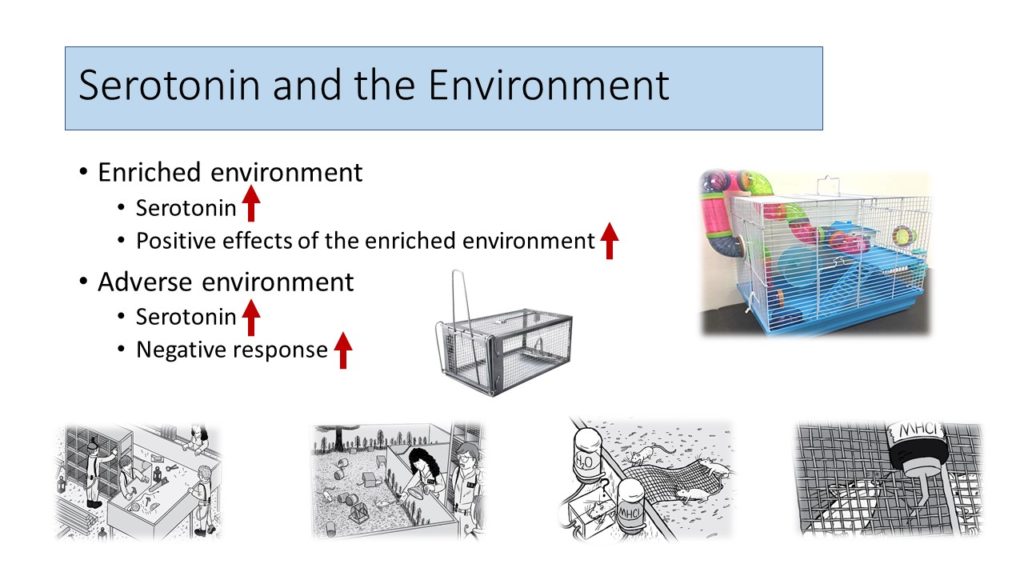
Selective serotonin reuptake inhibitors (SSRIs, like Prozac) increase levels of serotonin in the synaptic cleft. However, such evidence may provide insight into why SSRIs don’t work for everyone. While there is a great amount of evidence which describes the effectiveness of SSRIs, we must consider who is able to access such treatments. SSRIs may not be as effective in populations in more adverse environments (for example, in those lacking safe, secure housing) compared to those who are able to access healthcare and live in more enriched environments.
LEARN MORE: Psychedelics and the essential importance of context
LEARN MORE: Serotonin, psychedelics and psychiatry
LEARN MORE: Developmental changes in serotonin signaling: Implications for early brain function, behavior and adaptation
LEARN MORE: The role of selective serotonin reuptake inhibitors in preventing relapse of major depressive disorder
LEARN MORE: How do antidepressants work? New perspectives for refining future treatment approaches
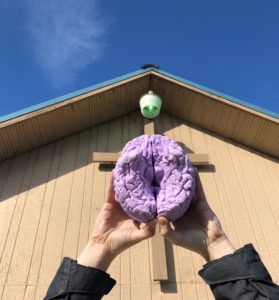
Classical psychedelics also appear to offer a sense of “generic” spirituality. Christians often find Christ, Buddhists find the Buddha, and Atheists find the “entire universe.”
“The usual antonym for the word ‘spiritual’ is ‘material.’ That at least is what I believed when I began this inquiry—that the whole issue with spirituality turned on a question of metaphysics. Now I’m inclined to think a much better and certainly more useful antonym for ‘spiritual’ might be ‘egotistical.’”
― Michael Pollan
Whatever your belief system is, that is often what manifests, and it speaks to you, along with a disorientation of ego, when one’s sense of self fundamentally changes. This is potentially helpful in the treatment of many mental health issues, including alcohol use disorder. If your ego persuades you that it’s ok to drink 26 ounces of vodka every night…then your belief system needs to be disoriented!
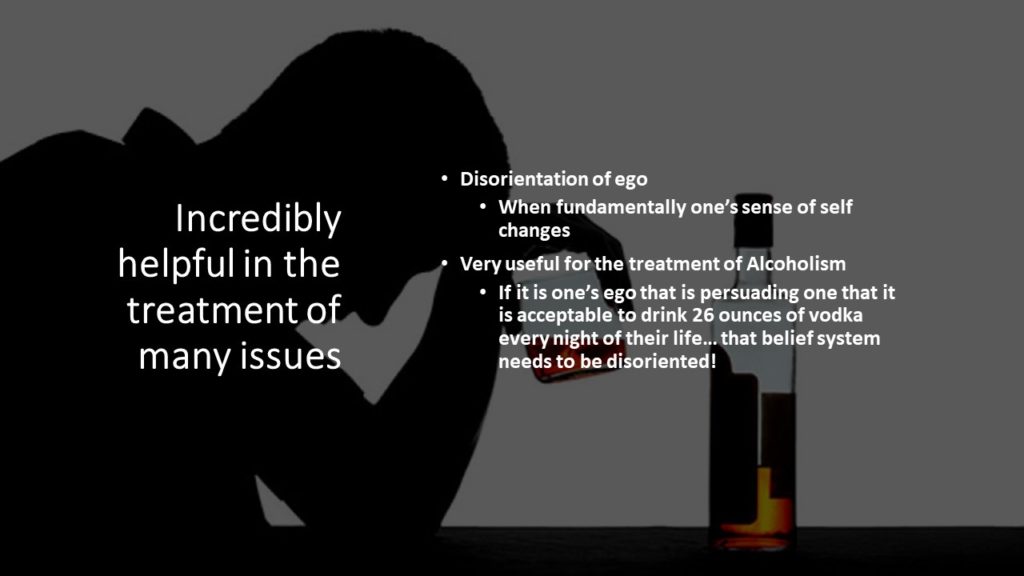
“Bill Wilson, the cofounder of Alcoholics Anonymous,…credited his own sobriety to a mystical experience he had on belladonna…Few members of AA realize that the whole idea of a spiritual awakening leading one to surrender to a ‘higher power’—a cornerstone of Alcoholics Anonymous—can be traced to a psychedelic drug trip.”
― Michael Pollan
LEARN MORE: LSD could help alcoholics stop drinking, AA founder believed
LEARN MORE: Atropa belladonna neurotoxicity: Implications to neurological disorders
LEARN MORE: Values and beliefs of psychedelic drug users: a cross-cultural study
LEARN MORE: Lysergic acid diethylamide (LSD) for alcoholism: meta-analysis of randomized controlled trials
LEARN MORE: Psilocybin-assisted treatment for alcohol dependence: a proof-of-concept study
Psychedelics also offer a “portal effect” (or a “wow that was incredible” effect). Like climbing Mount Everest or graduating from university there is a sense of major accomplishment, achievement, and transition. That can be useful for treating challenging substance use disorders, withdrawals and detox, depression and anxiety disorders.
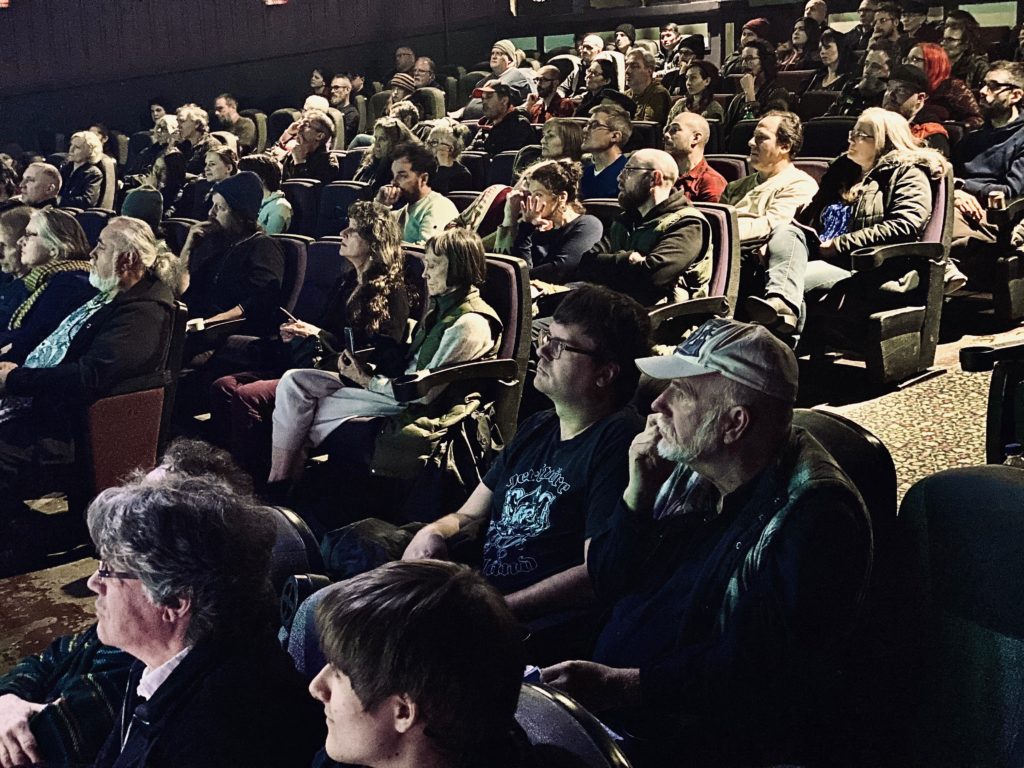
LEARN MORE: Robin Carhart-Harris on psychedelics and the unconscious
LEARN MORE: Pilot study of psilocybin treatment for anxiety in patients with advanced-stage cancer
LEARN MORE: Pilot study of the 5-HT2AR agonist psilocybin in the treatment of tobacco addiction
Therapeutic alliance is the greatest predictor of success in every orientation of psychotherapy. Psychedelics are alliance building medications. Psychedelics help one to reflect on one’s self and they reduce fear of treatments for multiple disorders.
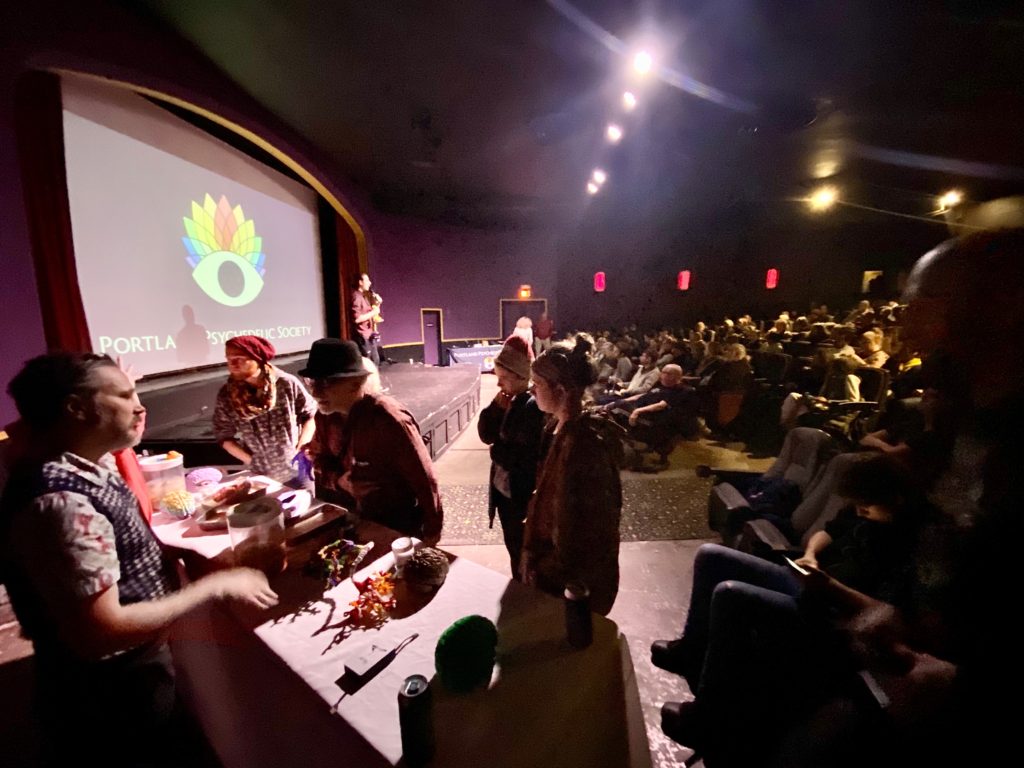
Psychedelics and depression
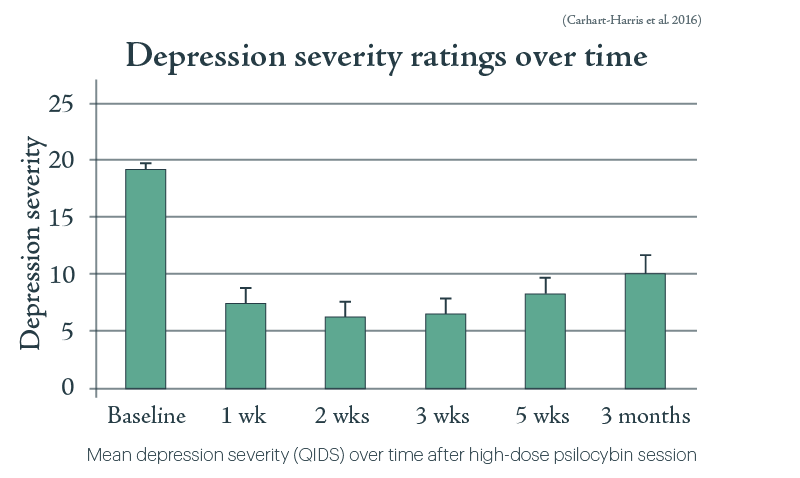
LEARN MORE: Psilocybin for Depression Study
LEARN MORE: Psilocybin for treatment-resistant depression: fMRI-measured brain mechanisms
LEARN MORE: Psychological variables implied in the therapeutic effect of ayahuasca: a contextual approach
LEARN MORE: Psilocybin with psychological support improves emotional face recognition in treatment-resistant depression
LEARN MORE: Psilocybin with psychological support for treatment-resistant depression: an open-label feasibility study
Psychedelics and PTSD

LEARN MORE: Current Perspective on MDMA-Assisted Psychotherapy for Posttraumatic Stress Disorder
LEARN MORE: Psychedelic compound in ecstasy moves closer to approval to treat PTSD
While classical psychedelics are non-toxic and have a low addiction potential there are still dangers associated with their use. People have died engaging in dangerous behaviors while under the influence of these drugs, and as they are federally illegal Schedule 1 substances, there is no guarantee that a particular sample is what it’s claimed to be.
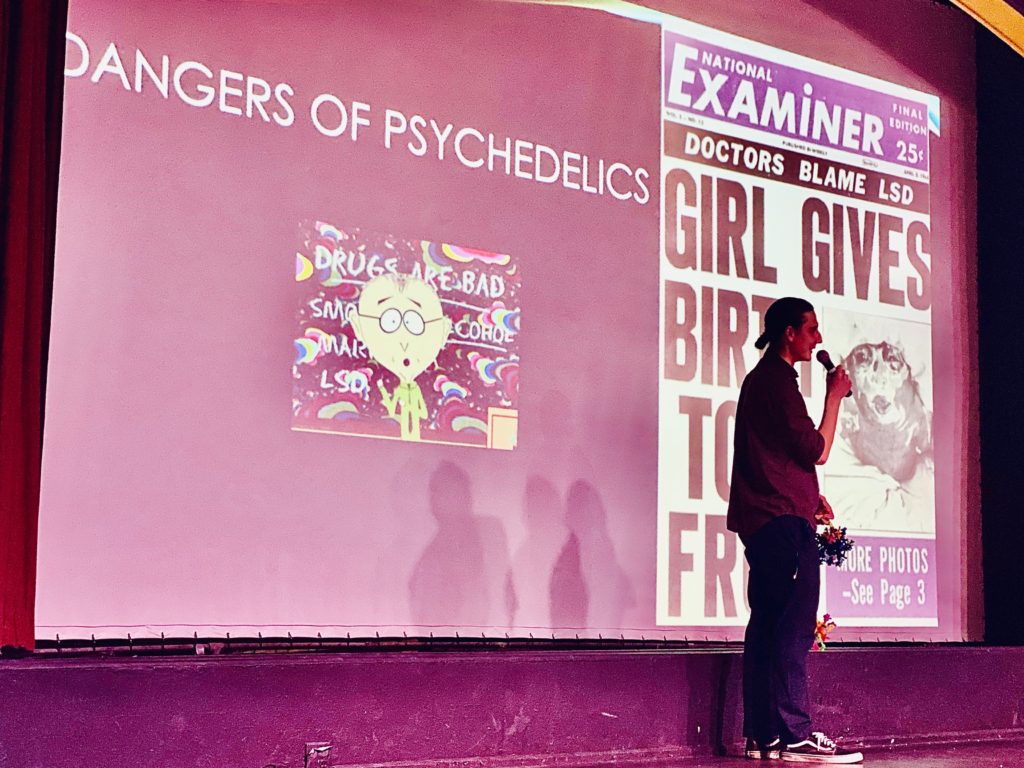
LEARN MORE: The abuse potential of medical psilocybin according to the 8 factors of the Controlled Substances Act
LEARN MORE: User perceptions of the benefits and harms of hallucinogenic drug use: A web-based questionnaire study
LEARN MORE: A Public-Health-Based Vision for the Management and Regulation of Psychedelics
LEARN MORE: Taking Psychedelics Seriously
LEARN MORE: Deaths from 25I-NBOMe (2C-I-NBOMe)
But clearly these drugs should be investigated further. And if you are interested in becoming a psychedelic researcher, there are a few important things to keep in mind.
“Unfortunately, psychedelics are still heavily stigmatized, and there is as yet no obvious infrastructure into which enthusiasts can channel their energy. There are no psychedelic research graduate programs, no psychedelic student groups, no psychedelic scholarships, and few professors willing to provide mentorship or funding agencies willing to sponsor such research.”
–R. Andrew Sewell, MD
LEARN MORE: So You Want to be a Psychedelic Researcher? R. Andrew Sewell, MD Answers
And if you want to become a psychedelic clinician, you can explore training programs and degrees in what’s known as “transpersonal orientated psychotherapy.”
The California Institute of Integral Studies offers a certificate in Psychedelic-Assisted Therapies and Research. It may also be worthwhile to explore MAPS’ MDMA Therapy Training Program. I would also recommend attending a Zendo Project Training Session and join as a peer support volunteer at festivals such as Burning Man. You can also start your own practice as a holistic therapist. Above all, practice self-care and stay within the law to avoid unnecessary consequences.

LEARN MORE: The Therapeutic Potential of Psychedelic Drugs: Past, Present, and Future



